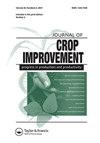Antagonistic effect of Leuconostoc mesenteroides on grapevine crown gall and fire blight
IF 1.5
Q3 AGRONOMY
引用次数: 0
Abstract
ABSTRACT Grapevine crown gall, caused by Allorhizobium vitis (A. vitis) and fire blight, caused by Erwinia amylovora (E. amylovora) of rosaceous plants, have been recognized as serious bacterial diseases and responsible for major crop losses in grapevine (Vitis vinifera L.), pear (Pyrus communis L.) and apple (Malus domestica Borkh.) worldwide. To develop an effective biocontrol method against the two bacterial pathogens, lactic acid bacteria (LAB) isolated from agricultural irrigation canals were tested as biocontrol agents. Thirty-two bacterial isolates were screened for their in vitro antagonistic activity. Four isolates (MS-1, MS-2, MS-3, and MS-4), identified by partial sequencing of 16S rRNA as Leuconostoc mesenteroides subsp. Jonggajibkimchii, were found to significantly inhibit the growth of A. vitis and E. amylovora in vitro. The biocontrol efficiency of these strains was tested against E. amylovora on immature pear fruits under laboratory conditions, and against A. vitis in tomato (Solanum lycopersicum L.) and kalanchoe (Kalanchoe daigremontiana) plants, under greenhouse conditions. Results showed that all selected antagonists were able to suppress fire blight disease on immature pear fruits. On tomato plants, the MS-1 and MS-2 strains were able to reduce the A. vitis infection by 82% and 99%, respectively. Similarly, the MS-2 strain reduced gall formation on kalanchoe plants by 99%. We concluded that Leuconostoc mesenteroides subsp. Jonggajibkimchii strains could serve as a potential biocontrol agent against fire blight and grapevine crown gall diseases.间质明串珠菌对葡萄冠胆和火疫病的拮抗作用
摘要葡萄冠病是由葡萄异根根瘤菌(A.vitis)引起的,火疫病是由蔷薇科植物的淀粉温氏菌(E.amylovora)引起的。葡萄冠病已被公认为严重的细菌性疾病,是造成葡萄、梨和苹果产量损失的主要原因。为了开发一种有效的生物防治方法,对从农田灌溉渠道中分离的乳酸菌(LAB)进行了生物防治试验。对32株细菌进行了体外拮抗活性筛选。四个分离株(MS-1、MS-2、MS-3和MS-4),通过16S rRNA部分测序鉴定为间质明串珠菌亚种。Jonggajibkimchii在体外可显著抑制葡萄和淀粉样葡萄的生长。在实验室条件下,测试了这些菌株对未成熟梨果实上的淀粉样芽孢杆菌的生物防治效率,以及在温室条件下对番茄(Solanum lycopersicum L.)和卡兰乔(kalanchoe daigremontiana)植物上的葡萄A.vitis的生物防治效果。结果表明,所筛选的拮抗剂均能抑制梨幼果的火疫病。在番茄植株上,MS-1和MS-2菌株能够分别减少82%和99%的葡萄球菌感染。类似地,MS-2菌株使卡兰科植物的胆囊形成减少了99%。我们得出结论,明串珠介孔菌亚种。Jonggajibkimchii菌株可以作为一种潜在的生物防治剂来防治葡萄枯萎病和葡萄冠病。
本文章由计算机程序翻译,如有差异,请以英文原文为准。
求助全文
约1分钟内获得全文
求助全文
来源期刊

Journal of Crop Improvement
Multiple-
CiteScore
3.30
自引率
7.70%
发文量
42
期刊介绍:
Journal of Crop Science and Biotechnology (JCSB) is a peer-reviewed international journal published four times a year. JCSB publishes novel and advanced original research articles on topics related to the production science of field crops and resource plants, including cropping systems, sustainable agriculture, environmental change, post-harvest management, biodiversity, crop improvement, and recent advances in physiology and molecular biology. Also covered are related subjects in a wide range of sciences such as the ecological and physiological aspects of crop production and genetic, breeding, and biotechnological approaches for crop improvement.
 求助内容:
求助内容: 应助结果提醒方式:
应助结果提醒方式:


